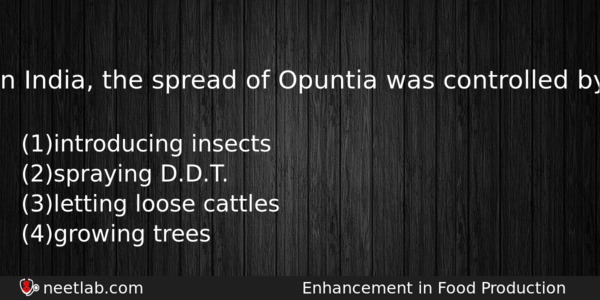| ⇦ | 
| ⇨ |
In India, the spread of Opuntia was controlled by
Options
(a) introducing insects
(b) spraying D.D.T.
(c) letting loose cattles
(d) growing trees
Correct Answer:
introducing insects
Explanation:
The control of pests by biological (rather than chemical) means is achieved by breeding disease-resistant crops or by introducing a natural enemy of the pest, such as a parasite or predator, e.g. control of the prickly pear cactus (Opuntia) was done by introducing the cactus moth (Cactoblastis, Cactorum) whose caterpillars feed on the growing shoots of the plants.
Related Questions: - Response to contact is known as
- Which bacterium is used extensively as biopesticide?
- The type of placentation in which ovary is syncarpus unilocular and ovules
- Which of the following is formed in S. Miller’s classic experiment?
- Nucellar polyembryony is reported in species of
Topics: Enhancement in Food Production
(101)
Subject: Biology
(4253)
Important MCQs Based on Medical Entrance Examinations To Improve Your NEET Score
- Response to contact is known as
- Which bacterium is used extensively as biopesticide?
- The type of placentation in which ovary is syncarpus unilocular and ovules
- Which of the following is formed in S. Miller’s classic experiment?
- Nucellar polyembryony is reported in species of
Topics: Enhancement in Food Production (101)
Subject: Biology (4253)
Important MCQs Based on Medical Entrance Examinations To Improve Your NEET Score
18000+ students are using NEETLab to improve their score. What about you?
Solve Previous Year MCQs, Mock Tests, Topicwise Practice Tests, Identify Weak Topics, Formula Flash cards and much more is available in NEETLab Android App to improve your NEET score.
Share this page with your friends

Leave a Reply